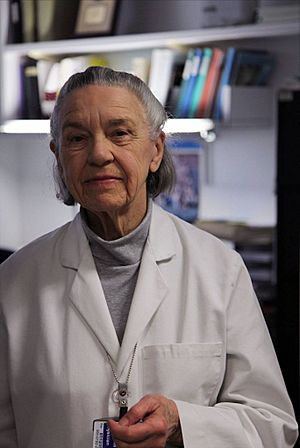Martha Vaughan facts for kids
Quick facts for kids
Martha Vaughan
|
|
|---|---|
 |
|
| Born | August 4, 1926 |
| Died | September 13, 2018 (aged 92) |
| Alma mater | University of Chicago Yale School of Medicine |
| Spouse(s) | Jack Orloff, M.D |
| Scientific career | |
| Fields | Biochemistry |
| Institutions | National Institutes of Health, National Heart Lung and Blood Institute |
| Notable students | Ferid Murad |
Martha Vaughan (born August 4, 1926 – died September 13, 2018) was an American biochemist. She worked at the National Heart Lung and Blood Institute (NHLBI). This is part of the National Institutes of Health (NIH) in Bethesda, Maryland.
She was an important scientist in the Laboratory of Metabolic Regulation. Before that, she led the NHLBI’s Laboratory of Cellular Metabolism. At the NIH, much of her research focused on how cells communicate. This is called cell signaling. She also studied how cells are controlled and how fats are processed (lipid metabolism).
Dr. Vaughan also helped find key proteins linked to cholera toxin and pertussis toxin. She first joined the NIH in the early 1950s. She worked on how proteins are made (protein synthesis) with Christian B. Anfinsen. He later won the 1972 Nobel Prize in Chemistry.
Martha Vaughan was also a great mentor to other scientists. One of them was Ferid Murad, who won the Nobel Prize in 1998. He worked in her lab in the late 1960s. Dr. Murad said she was an "excellent mentor" and gave him "considerable freedom."
Dr. Vaughan worked at the NIH for more than 60 years. She was active in many science groups. She also helped manage research related to translational medicine and cell metabolism.
Education and Early Career
Martha Vaughan was born in Wisconsin. In 1944, she earned her first degree from the University of Chicago. A famous geneticist, Janet Rowley, was her classmate there.
In 1949, Dr. Vaughan received her M.D. degree from the Yale School of Medicine. She then started her research career at Yale. She also completed her internship at Yale–New Haven Hospital.
While at Yale in 1949, she led the Yale chapter of a group called the Association of Internes and Medical Students (AIMS). This group was for young doctors. It worked on important issues like the rights of medical students. It also supported universal health insurance and equal rights in medical education.
Awards and Recognition
In 1985, Dr. Vaughan was chosen to be a member of the National Academy of Sciences. This is a very high honor for scientists. She also served on its Committee on Human Rights.
In 1991, she became a Fellow of the American Academy of Arts and Sciences. She received many awards from the U.S. Department of Health and Human Services. These awards recognized her important work. In 2001, three Nobel Prize winners took part in a special event to honor her.
Personal Life
Martha Vaughan was married to another NIH scientist, Jack Orloff, M.D. He was a kidney specialist. He also served as the scientific director for NHLBI from 1974 to 1988.
The National Heart Lung and Blood Institute still gives an annual science award in Dr. Orloff's name. Both Dr. Vaughan and Dr. Orloff started working at the NIH in the early 1950s.

